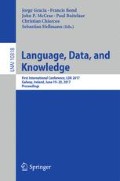Abstract
In this article we describe our ongoing attempts to use the Semantic Web Rule Language (SWRL) to model the morphological layer of a wide-coverage Italian lexical resource, Parole-Simple-Clips (PSC); in this case that subset of PSC dealing with Italian noun morphology. After giving a brief introduction to SWRL and to Italian noun morphology we go onto describe the actual transformation itself. Finally we describe an experiment on our dataset using SWRL rules and queries written in the Semantic Query-Enhanced Rule Web Language (SQWRL).
Access this chapter
Tax calculation will be finalised at checkout
Purchases are for personal use only
Notes
- 1.
- 2.
Note that here we intend ‘extensional description’ to refer to cases in which the inflected forms of a lexeme are explicitly given in a lexicon, and ‘intensional’ to cases where such forms are represented implicitly through morphological patterns that can be used to generate them.
- 3.
See for instance the morphological pattern for the inflection of adjectives at http://www.tagmatica.fr/lmf/FrenchLMFTestSuites1.xml.
- 4.
Note that as we are looking at the use of SWRL explicitly as a Semantic Web-based rule language we will not, in this article, make comparisons between our work and the existing literature on modelling natural language morphology using other logic programming languages like Prolog. Our emphasis here is on making morphological data accessible using Semantic Web technologies.
- 5.
- 6.
For a good introduction to Italian noun morphology see [4].
- 7.
These API’s can be found respectively at http://owlapi.sourceforge.net/ and https://github.com/protegeproject/swrlapi.
- 8.
- 9.
This percentage is taken over the total number of nouns assigned to a morphological class.
References
D’Achille, P., Thornton, A.M.: La flessione del nome dall’italiano antico all’italiano contemporaneo (2003)
Del Gratta, R., Frontini, F., Khan, F., Monachini, M.: Converting the PAROLE SIMPLE CLIPS Lexicon into RDF with lemon. Semant. Web (Print) 6, 387–392 (2015)
Francopoulo, G.: LMF Lexical Markup Framework. Wiley, New York (2013)
Iacobini, C., Thornton, A.M.: Morfologia e formazione delle parole. Manuale di linguistica italiana 13, 190 (2016)
Klimek, B., Arndt, N., Krause, S., Arndt, T.: Creating linked data morphological language resources with mmoon - the hebrew morpheme inventory. In: Proceedings of the 10th International Conference on Language Resources and Evaluation (LREC 2016) (2016)
McCrae, J., Spohr, D., Cimiano, P.: Linking lexical resources and ontologies on the semantic web with lemon. In: Antoniou, G., Grobelnik, M., Simperl, E., Parsia, B., Plexousakis, D., Leenheer, P., Pan, J. (eds.) ESWC 2011. LNCS, vol. 6643, pp. 245–259. Springer, Heidelberg (2011). doi:10.1007/978-3-642-21034-1_17
O’Reilly, C., Paurobally, S.: Lassoing rhetoric with owl and swrl. Unpublished MSc dissertation (2010). http://computationalrhetoricworkshop.uwaterloo.ca/wpcontent/uploads/2016/06/LassoingRhetoricWithOWLAndSWRL.pdf
Wilcock, G.: An owl ontology for HPSG. In: Proceedings of the 45th Annual Meeting of the ACL on Interactive Poster and Demonstration Sessions, ACL 2007, Association for Computational Linguistics, Stroudsburg, PA, USA, pp. 169–172 (2007)
Author information
Authors and Affiliations
Corresponding author
Editor information
Editors and Affiliations
Rights and permissions
Copyright information
© 2017 Springer International Publishing AG
About this paper
Cite this paper
Khan, F., Bellandi, A., Frontini, F., Monachini, M. (2017). Using SWRL Rules to Model Noun Behaviour in Italian. In: Gracia, J., Bond, F., McCrae, J., Buitelaar, P., Chiarcos, C., Hellmann, S. (eds) Language, Data, and Knowledge. LDK 2017. Lecture Notes in Computer Science(), vol 10318. Springer, Cham. https://doi.org/10.1007/978-3-319-59888-8_11
Download citation
DOI: https://doi.org/10.1007/978-3-319-59888-8_11
Published:
Publisher Name: Springer, Cham
Print ISBN: 978-3-319-59887-1
Online ISBN: 978-3-319-59888-8
eBook Packages: Computer ScienceComputer Science (R0)

